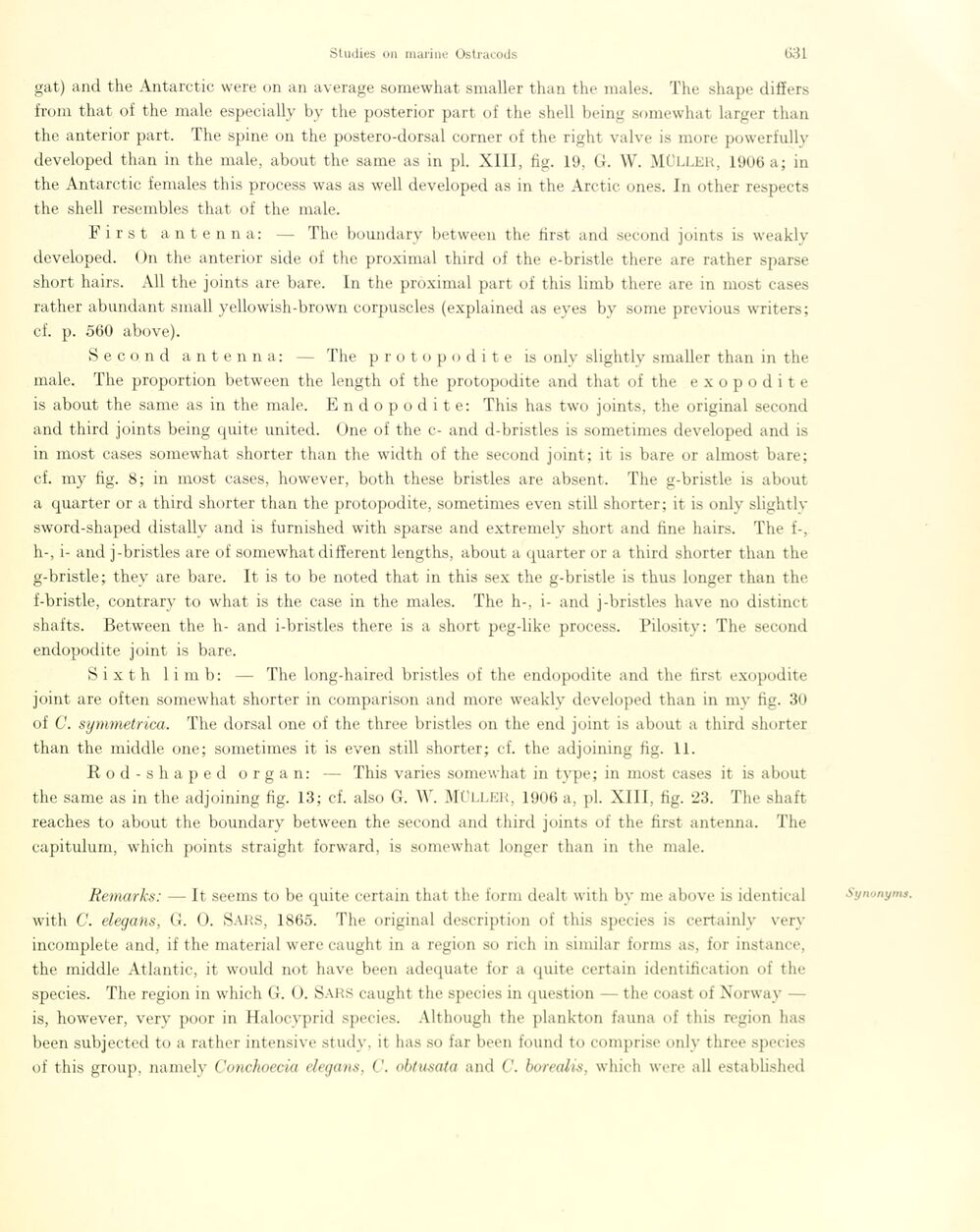
Full resolution (JPEG) - On this page / på denna sida - Sidor ...

<< prev. page << föreg. sida << >> nästa sida >> next page >>
Below is the raw OCR text
from the above scanned image.
Do you see an error? Proofread the page now!
Här nedan syns maskintolkade texten från faksimilbilden ovan.
Ser du något fel? Korrekturläs sidan nu!
This page has never been proofread. / Denna sida har aldrig korrekturlästs.
gat) and the Antarctic vvere on an average somewhat smaller than the males. The shape differs
from that of the male especially by the posterior part of the shell being somewhat larger than
the anterior part. The spine on the postero-dorsal corner of the right valve is more powerfully
developed than in the male, about the same as in pl. XIII, fig. 19, G. W. MÜLLER, 1906 a; in
the Antarctic females this process was as well developed as in the Arctic ones. In other respects
the shell resembles that of the male.
First antenna: — The boundary between the first and second joints is weakly
developed. On the anterior side of the proximal third of the e-bristle there are rather sparse
short hairs. Ail the joints are bare. In the proximal part of this limb there are in most cases
rather abundant small yellowish-brown eorpuscles (explained as eyes by some previous writers;
cf. p. 560 above).
Second antenna: — The protopodite is only slightly smaller than in the
male. The proportion between the length of the protopodite and that of the exop odite
is about the same as in the male. Endopodite: This has two joints, the original second
and third joints being quite united. One of the c- and d-bristles is sometimes developed and is
in most cases somewhat shorter than the width of the second joint; it is bare or almost bare;
cf. my fig. 8; in most cases, however, both these bristles are absent. The g-bristle is about
a quarter or a third shorter than the protopodite, sometimes even still shorter; it is only slightly
sword-shaped distally and is furnished with sparse and extremely short and fine hairs. The f-,
h-, i- and j-bristles are of somewhat different lengths, about a quarter or a third shorter than the
g-bristle; they are bare. It is to be noted that in this sex the g-bristle is thus longer than the
f-bristle, contrary to what is the case in the males. The h-, i- and j-bristles have no distinct
shafts. Between the h- and i-bristles there is a short peg-like process. Pilosity: The second
endopodite joint is bare.
Sixth limb: — The long-haired bristles of the endopodite and the first exopodite
joint are often somewhat shorter in comparison and more weakly developed than in my fig. 30
of C. symmetrica. The dorsal one of the three bristles on the end joint is about a third shorter
than the middle one; sometimes it is even still shorter; cf. the adjoining fig. 11.
Rod-shaped organ: — This varies somewhat in type; in most cases it is about
the same as in the adjoining fig. 13; cf. also G. IV. MÜLLER, 1906 a, pl. XIII, fig. 23. The shaft
reaches to about the boundary between the second and third joints of the first antenna. The
capitulum, which points straight forward, is somewhat longer than in the male.
Remarks: — It seems to be quite certain that the form dealt with by me above is identical
with C. elegans, G. O. SARS, 1865. The original description of this species is certainly very
incomplete and, if the material were caught in a region so rieh in similar forms as, for instance,
the middle Atlantic, it would not have been adéquate for a quite certain identification of the
species. The région in which G. O. SARS caught the species in question — the coast of Norway
-is, however, very poor in Halocyprid species. Although the plankton fauna of this region has
been subjeeted to a rather intensive study, it has so far been fourni to comprise onlv three species
of this group, namely Conchoecia elegans, C. obtusala and C. borealis, which were all established
Synonyms.
<< prev. page << föreg. sida << >> nästa sida >> next page >>